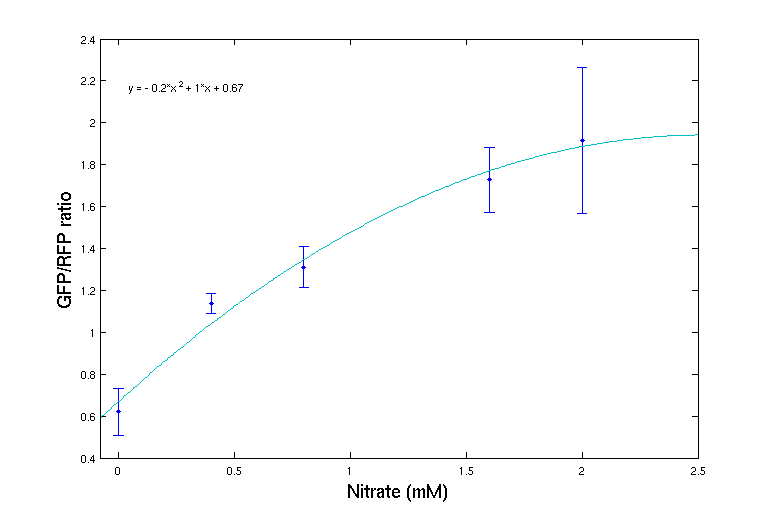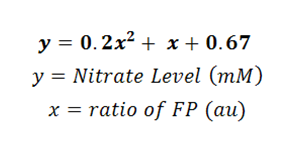Team:BCCS-Bristol/Wetlab/characterising ratio
From 2010.igem.org
iGEM 2010
Characterising the Ratio Method
Motivation
Contents |
To solve this problem we implemented our ratio method; transforming our E. coli with both our new BioBrick and another BioBrick from the parts registry BBa_J04450 - coding for constitutive RFP production. This then allows GFP readings to be compared against a baseline RFP reading, with the overall ratio of fluorescent proteins being used as the measure of Nitrate in solution or soil.
Double Transformations
We started by transforming 'E. coli' MG1655 with our new BioBrick and one encoding constitutive RFP production following standard transformation methods - mixing 100μL of MG1655 with 2μL of BBa_K381001 and 2μL of BBa_J04450. Colonies from this transformation were then used in all subsequent assays here.
0 - 10mM Assay
Having made our double transformants the next step was to characterise their response to Nitrate. We began by examining this between 0 and 10mM of Potassium Nitrate (in 2mM steps). 5mL solutions of LB and Potassium Nitrate were made up in sterilins and inoculated with the same colony of MG1655s. These were then left overnight at 37°C and their fluorescence analysed using the photo-spectrometer the next morning. This gave results as follows (Where data is missing, colonies produced neither GFP nor RFP, thus were discounted as failures, note how this highlights the usefulness of the double transform method in stopping false negatives):
| Nitrate (mM) | GFP | RFP | GFP / RFP |
| 0 | 0.045 | 0.0205 | 0.45556 |
| 2 | 0.061 | 0.1057 | 1.73279 |
| 4 | n/a | n/a | n/a |
| 6 | 0.0522 | 0.1128 | 2.16092 |
| 8 | n/a | n/a | n/a |
| 10 | 0.0429 | 0.1185 | 2.76224 |
As is evident from the graph below there is a clear trend of an increase in GFP/RFP with increasing Nitrate levels, indicating our ratio solution did work as anticipated.
0 - 2mM Assay
Having established our ratio method worked between 0 - 10mM KNO3, we were keen to check whether it worked at levels more relevant to our particular project. Consultation with farmers established typical Nitrate levels in soil lay began 0 - 2mM, thus we decided to characterise the double transformants further in this range.
As before, 5mL solutions of LB and Potassium Nitrate were set up, inoculated, and left overnight at 37°C. We then analysed their fluorescence using the photo-spectrometer, yielding the following results:
| Nitrate (mM) | ratio test 1 | ratio test 2 | ratio test 3 | average |
| 0 | n/a | 0.70025 | 0.54227 | 0.62126 |
| 0.4 | 1.17228 | n/a | 1.10214 | 1.13721 |
| 0.8 | n/a | 1.34615 | 1.27687 | 1.31151 |
| 1.2 | n/a | n/a | n/a | n/a |
| 1.6 | n/a | 1.83442 | 1.61957 | 1.727 |
| 2.0 | 1.41866 | n/a | 2.414 | 1.91633 |
Again this allowed us to plot a graph indicating behaviour that shows a clear upward relationship between ratio of fluorescent proteins and Nitrate, indicating our ratio method works well not only across a broad range, but also within the Nitrate levels that are important for this project.
Finally, this data allowed us to formulate an equation linking the fluorescence to Nitrate levels:
Conclusions
We were extremely pleased with these results. Not only had we solved the problem of misleading GFP results, but also formed an equation linking the readings that would be picked up by a farmer with his tractor to actual Nitrate levels, something that would be essential when creating a marketable product.
 "
"


